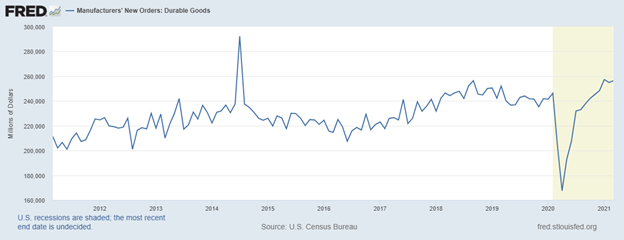One of the few forward-looking economic reports is the monthly data from the Census Bureau on new orders for durable goods.
New orders for durable goods rose 0.5% in March. Durable goods are products designed to last at least three years. They include kitchen appliances, computers and industrial machinery used in factories.
It was the tenth time in the last 11 months that new orders increased.
Durable Goods Orders Have Increased

Source: Federal Reserve.
Durable Goods Orders Suggest Bullish Stock Market
Ignoring the spike in 2014 due to reporting changes, the data series is at new all-time highs.
Trends in durable goods orders reflect consumer and business confidence. This is one of the few economic data reports that offer insights into both business and consumer finances.
New orders for durable goods are among the few indicators that combine consumer and business confidence — making it an important leading economic indicator.
Consumers make big purchases when they’re optimistic about the future. That’s especially true for financed purchases. Financing shows confidence in the ability to make payments.
Pessimistic consumers delay purchases. Think of your household. If you’re worried about losing your job, you probably avoid new debt. This idea applies to the larger economy. Millions of households behave that way.
These same factors affect business decisions as well. Businesses make big purchases when managers are optimistic and defer decisions when they are pessimistic.
This indicator also forecasts trends in the stock market. Avoiding the stock market when new orders are lower than they were six months ago beats a buy-and-hold strategy.
The Commerce Department began publishing this data in 1992. That sell signal avoided every significant decline since then.
New orders for durable goods tell us the stock market could move higher, although there could be pullbacks along the way.
I don’t like working more than I have to.
That’s why I found a way to beat the market by making one simple trade per week.
Last year, this trade helped me beat the market eight times over.
It’s a great way to accelerate your gains. Click here, and I’ll show you how it works.
Michael Carr is a Chartered Market Technician for Banyan Hill Publishing and the Editor of One Trade, Peak Velocity Trader and Precision Profits. He teaches technical analysis and quantitative technical analysis at the New York Institute of Finance. Mr. Carr is also the former editor of the CMT Association newsletter, Technically Speaking.
Follow him on Twitter @MichaelCarrGuru.





